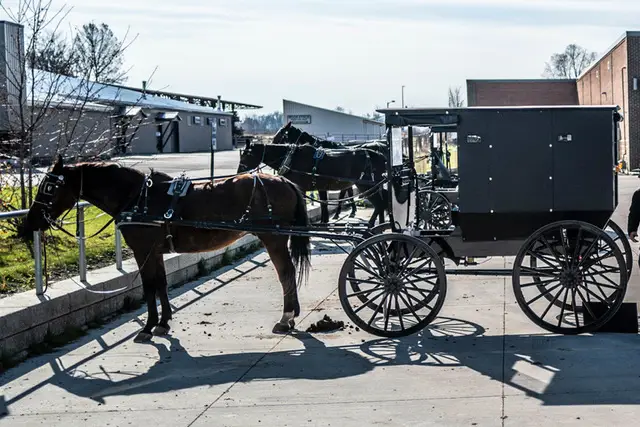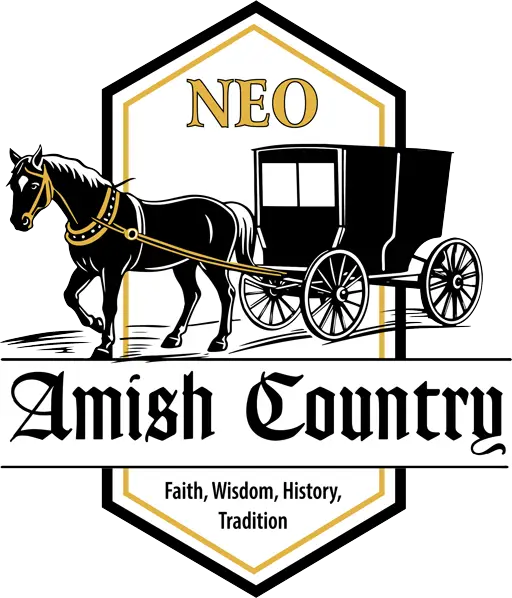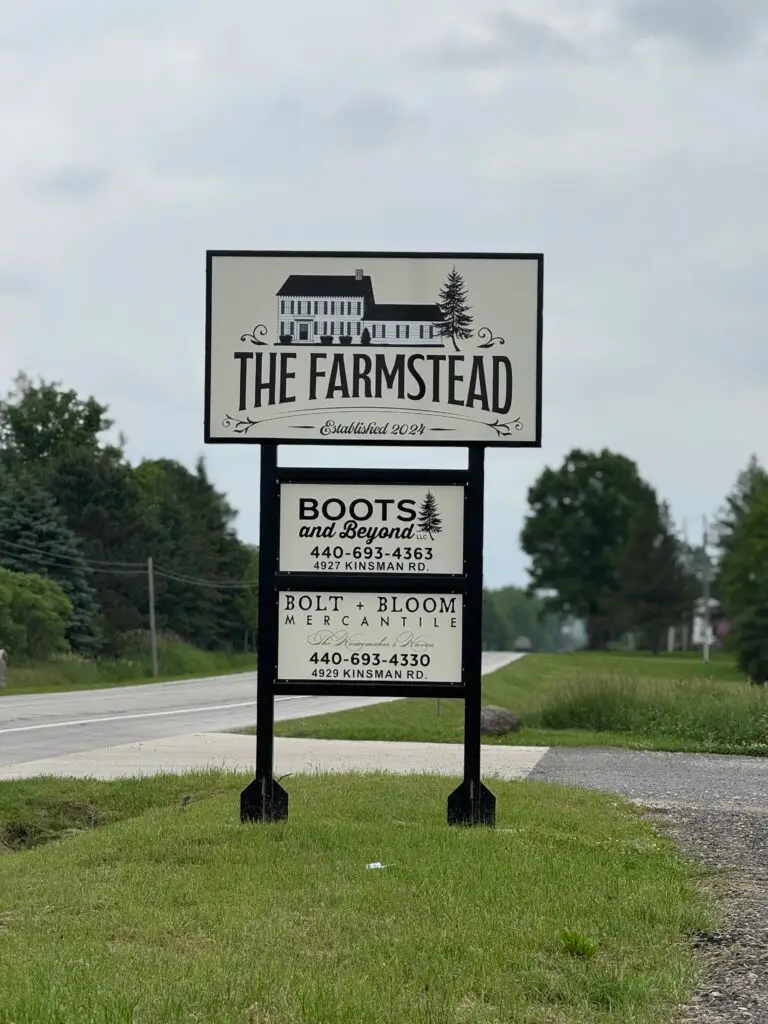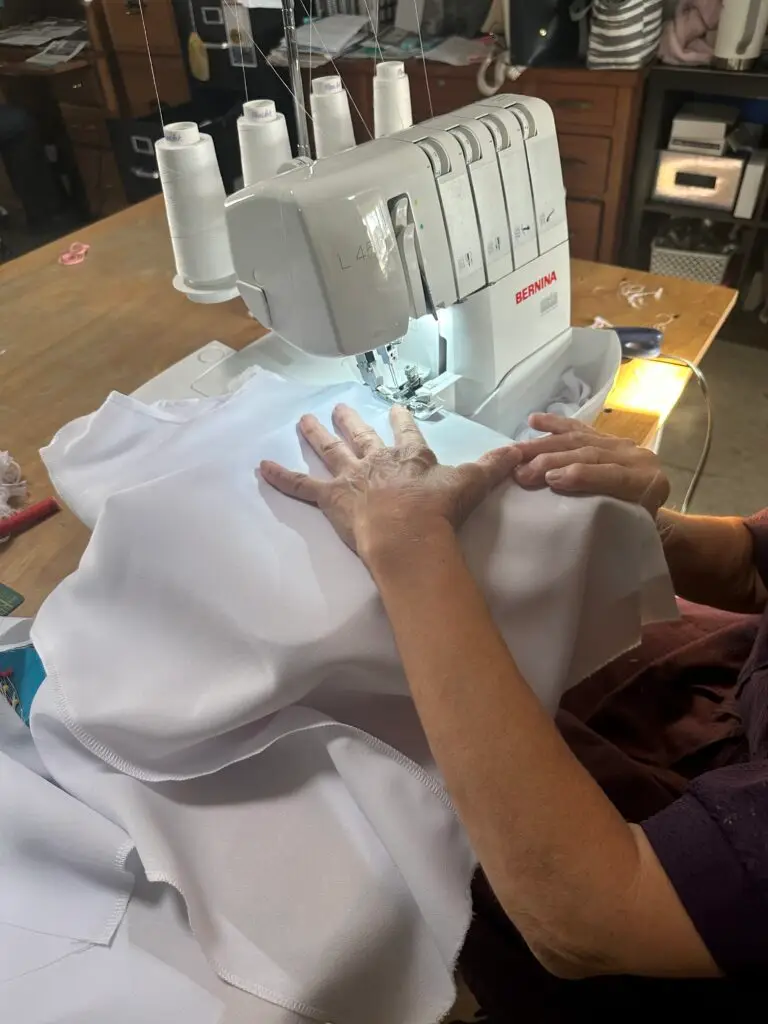By Nora Kurtz, Geauga Amish Historical Library
“How does an Amish family know which horse and buggy is theirs in a group of thirty or more horses and buggies when they all look the same?”
I was recently asked this question and found myself at a loss for a simple explanation. It’s much like a jacket or a pair of shoes. If a dozen people with the same brand, style, and size of footwear had them randomly placed in the center of the floor, the individuals would likely choose their own without difficulty. If a mistake were made, they’d know right away once they tried them on. This level of familiarity is almost ingrained.
Though Amish buggies appear similar at first glance, there are many subtle differences that make each one unique. For example, the step of our family buggy was slightly off-kilter. The back step was round, about four inches in diameter, and positioned around 15 inches off the ground. You had to step toward the higher edge to prevent foot slippage when entering. Other buggies have steps that are larger and lower to the ground.
Our buggy was a two-seater, with the back seat facing forward, just like the front seat. In contrast, some buggies are “side-seaters” where children sit on smaller seats facing each other, and these are entered from the back, unlike the others, which have side entrances. A unique feature of our buggy was the split windshield. If you needed to give your horse clearer instructions or simply wanted a breeze, the windshield could be lifted and secured to the ceiling with metal brackets. However, I wouldn’t recommend this in the spring, as the horse’s shedding hair could easily blow inside. The split design allowed just half of the windshield to be opened at a time.
Other, less obvious differences include lights, reflective tape, side mirrors, and mud flaps.
Buggy Identification at Funerals
In Amish communities, measures are sometimes taken to ensure the right buggy and horse are paired with their owner. At funerals, for example, a sort of “valet parking” system is employed. Amish funerals can be quite large, with many families coming from different church districts. The men of the deceased’s district unhitch the arriving families’ horses and park their buggies. They also hitch the horses again for the procession to the burial. To avoid mistakes, a piece of chalk is used to mark the buggies and harnesses.
Interestingly, buggies are lightweight and can easily be maneuvered by an average-strength person, making it essential to get off the road during high winds. A strong gust could easily push or topple a buggy.
The Evolution of “Buggy Technology”
Is “buggy technology” an oxymoron? My father, who grew up in Geauga County, remembers kerosene lanterns hanging on buggies for light. Today, most buggies are equipped with LED lights. Seats are cushioned and upholstered, and they can be lifted off the wooden frame for easier access to the battery beneath. A 12-volt car battery, once standard, has now been replaced in many buggies with lithium tool batteries that charge quickly and last longer. Some buggies even feature small solar panels on the roof, powering not just lights but heated seats as well. I recall the days when hot water bottles or warm potatoes in children’s pockets were the go-to solution for keeping warm.
Another technological advancement is hydraulic brakes, which replace the old “pad brakes” that applied pressure to the back wheels like a bicycle’s. Rubber fitting around the metal rim of the tires, once unheard of, is now commonplace.
Crafting and Sizing Amish Buggies
My father once built and repaired buggies as a side job, and I loved watching him work. I remember the intricate process of fitting metal rims onto wooden wheel frames. The metal was always about an eighth of an inch smaller than the wheel to ensure a tight fit, which he achieved by heating the metal in a small fire, then hammering it into place with gloves and tongs. Afterward, the metal was quickly cooled in water, releasing a dramatic hiss of steam.
The standard wheel size for Geauga County buggies is 38 inches for the front wheels and 42 inches for the back. However, for the elderly, smaller wheels—such as 34 inches for the front and 38 inches for the back—are often used, making it easier to get in and out of the buggy. Some communities also use smaller wheels and ramps to make the buggies wheelchair accessible.
Why state a standard wheel size for a specific county? Amish buggies can vary greatly from one community to the next. For example, in our community, buggies use curtains for closures, while in other areas, sliding doors are the norm. The curtains are fastened with large snap closures and can be rolled up when the weather is warm. Other differences include size, shape, lighting, and color. Some conservative Amish communities in Ohio, Pennsylvania, and New York even use white or bright yellow buggies, while “Swiss” Amish communities drive only open carriages.
The Cost and Care of Buggies
Several states now require license plates for buggies, though this was not the case in Geauga County. While license plates are no longer a requirement, buggies still require an annual fee to be paid to the local township. The average cost of a new family buggy (or surrey) is around $10,000, with additional features such as heated seats pushing the price higher. Used buggies are also widely available.
The Role of Horses
While much of the focus in this article has been on buggies, we can’t forget the horses that are the real workhorses behind this mode of transportation. These wonderful animals, each with its own personality, are essential for traveling in rain, snow, sleet, and heat. As children, we had many fond memories of our horses. Training a young horse to pull a buggy takes time. They are often driven in a two-wheeled cart on back roads to become “road ready.” Blinders, which shield their eyes from the side, help calm skittish horses.
I recently received a question from a young boy in Ukraine who asked, “What’s your favorite thing about being Amish?” I replied that one of my favorite things is traveling by horse and buggy. It’s soothing to the senses—the wind, the rocking motion, the smell of horse and leather, and the creaking of the harness. I particularly love the muffled sound of a horse’s hooves on a snow-packed road.
Amish communities may not be immune to the pressures of a fast-paced world, but our commitment to traveling by horse and buggy is central to our culture. It encourages us to slow down, live simply, and appreciate the beauty of God’s creation.
For more information about Amish buggies, visit Eric Wesner’s website, Amish America, and search “The 6 Amish Buggy Colors.”
Picture #1: Amish buggies at an auction in Mifflin County, Pennsylvania. The diversity in buggy styles is evident, with buggies featuring both curtains and sliding doors. (SEGQ Photos/GAHL)

Nora Kurtz is the Gift Shop Manager at the Geauga Amish Historical Library in Middlefield, Ohio.
15848 Nauvoo Road, Middlefield OH 44062
440-682-0606



